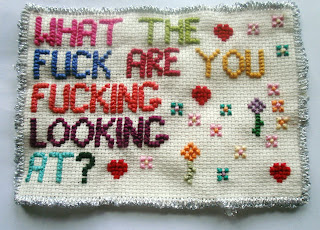WTF - Grafitti found on Glasgow wall.
I knew I had been captured by the art pixies when I realised I needed an easel. I spent time assessing easels, evaluating them, selecting a favourite easel to compare with other, less gifted easels. Easels…ah, easels, as used by proper artists while simultaneously holding a weird stick thing alongside their brush and pretending they know how to measure proportion with their thumb. Light wood, dark wood, so many lovely, lovely easels.
The art shop didn’t like the way I was handling the easels (look: I was feeling the grain of the wood) but I finally exhausted their tolerance for what the manager claimed was: “taking my clothes off” to do this (it was a mistake! I was hot! It was only my jumper! Jeesh.) (Mmmm easels….)
From my perspective, art practice is full of shiny new things, and I want to buy it all. I need these things. I must have them. An easel is essential, and I’m not joking. I have realised that the proportion of free hand drawing and paintings are distorted if you paint over them on a flat surface, whereas if they are held vertically in front the viewer, perspective is better. See, I am learning.
So many new things to buy, like brushes – I need brushes. Incidentally, I became a legend at The Art Store after asking aloud if they had any brushes in stock. Give me a break, I’m new to this. But so many questions remain: how many brushes do you need, and what are they all for? And horsehair; what’s that all about – is it made from real horses? That’s just cruel: those poor little bald ponies.
Oh well, as long as it makes helps make pretty pictures.
I’ve noticed that newbies start out with shiny stuff, whereas established hands scrabble to the bottom of the bargain bin for cut-price stubs of pastel, wads of scrap paper and shards of charcoal. I started out using a swish pad, containing all of twenty sheets. It didn’t last. Soon, I was grateful to find a cheap sketch book (respect to the woman using kids pads from the pound shop.)
Then there is the magical world of boxes, containers and storage. I spotted a neat pencil holder which was attached to a holster, and I want one more than words can say. Sadly, it was a present from America
Then there’s portfolios. Nothing makes you feel more a like a proper artist than glumly stomping around, lost in deep thought about Art, sideswiping toddlers and elderly passers-by before whacking them into the path of heavy traffic with a massive portfolio that contains a take-away menu and a rejection letter from Arts Council England (don’t they understand? It’s my Art. It’s my life!)
Then I remember that the best drawings I’ve seen recently were made by someone using one stubby pencil on random scraps of scabby old paper. There’s a lesson for me somewhere.












